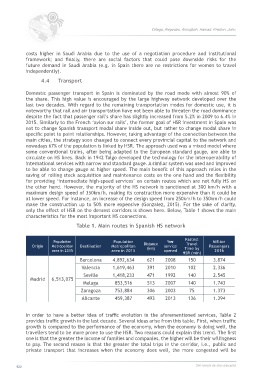Page 524 - 360.revista de Alta Velocidad - Nº 6
P. 524
Ortega, Alejandro. Almujibah, Hamad. Preston, John.
costs higher in Saudi Arabia due to the use of a negotiation procedure and institutional
framework; and finally, there are social factors that could pose downside risks for the
future demand in Saudi Arabia (e.g. in Spain there are no restrictions for women to travel
independently).
4.4 Transport
Domestic passenger transport in Spain is dominated by the road mode with almost 90% of
the share. This high value is encouraged by the large highway network developed over the
last two decades. With regard to the remaining transportation modes for domestic use, it is
noteworthy that rail and air transportation have not been able to threaten the road dominance
despite the fact that passenger rail’s share has slightly increased from 5.2% in 2009 to 6.4% in
2015. Similarly to the French ‘avion sur rails’, the former goal of HSR investment in Spain was
not to change Spanish transport modal share inside out, but rather to change modal share in
specific point to point relationships. However, taking advantage of the connection between the
main cities, the strategy soon changed to connect every provincial capital to the network and
nowadays 67% of the population is linked by HSR. The approach used was a mixed model where
some conventional trains, after being adapted to the European standard gauge, are able to
circulate on HS lines. Back in 1942 Talgo developed the technology for the interoperability of
international services with narrow and standard gauge. A similar system was used and improved
to be able to change gauge at higher speed. The main benefit of this approach relies in the
saving of rolling stock acquisition and maintenance costs on the one hand and the flexibility
for providing ‘intermediate high-speed services’ on certain routes which are not fully HS on
the other hand. However, the majority of the HS network is sanctioned at 300 km/h with a
maximum design speed of 350km/h, making its construction more expensive than it could be
at lower speed. For instance, an increase of the design speed from 250km/h to 350km/h could
make the construction up to 50% more expensive (Gonzalez, 2015). For the sake of clarity,
only the effect of HSR on the densest corridors is shown here. Below, Table 1 shows the main
characteristics for the most important HS connections.
Table 1. Main routes in Spanish HS network
Fastest
Population Population Year Million
Origin Metropolitan Destination Metropolitan Distance service Travel Passengers
area in 2015 area in 2015 (km) opened Time by 2016
HSR (min)
Barcelona 4,892,634 621 2008 150 3.874
Valencia 1,619,463 391 2010 102 2.336
Seville 1,418,233 471 1992 140 2.545
Madrid 6,513,075
Malaga 853,516 513 2007 140 1.743
Zaragoza 753,884 306 2003 75 1.373
Alicante 459,387 493 2013 136 1.394
In order to have a better idea of traffic evolution in the aforementioned services, Table 2
provides traffic growth in the last decade. Several ideas arise from this table. First, when traffic
growth is compared to the performance of the economy, when the economy is doing well, the
travellers tend to be more prone to use the HSR. Two reasons could explain this trend. The first
one is that the greater the income of families and companies, the higher will be their willingness
to pay. The second reason is that the greater the total trips in the corridor, i.e., public and
private transport that increases when the economy does well, the more congested will be
522 360.revista de alta velocidad

